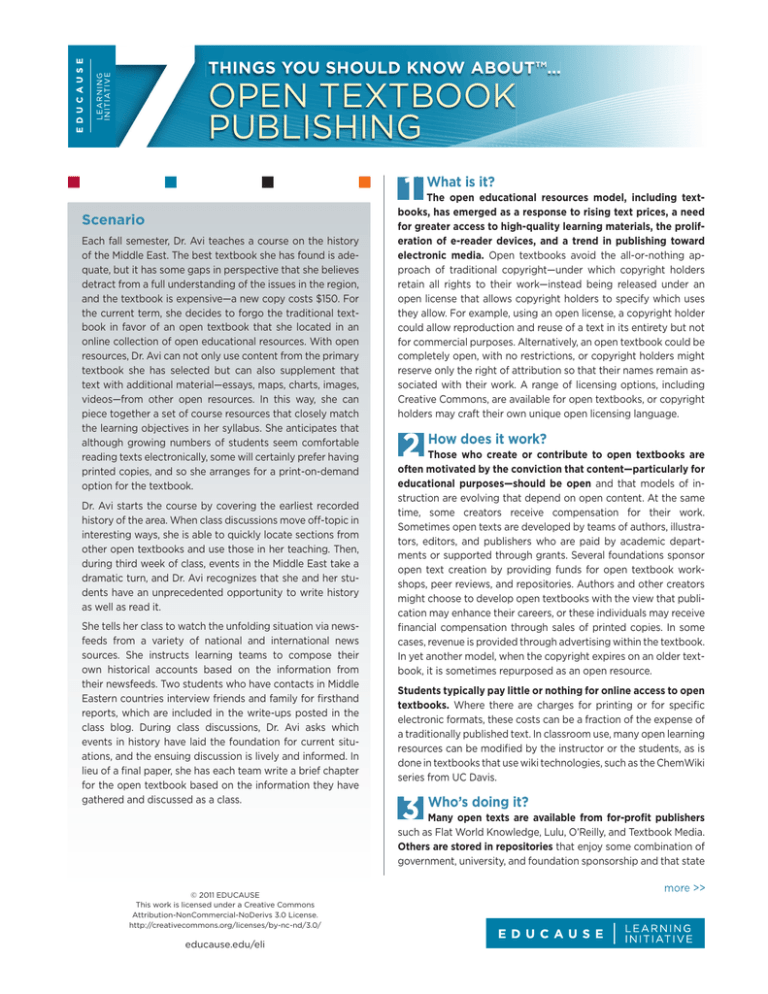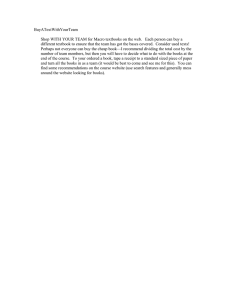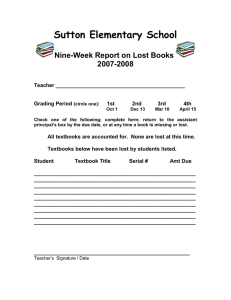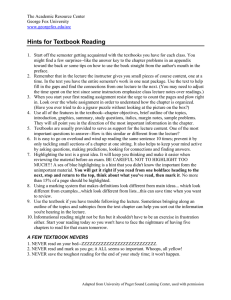7 Things You Should Know About Open Textbook Publishing
advertisement

THINGS YOU SHOULD KNOW ABOUT™… OPEN TEXTBOOK PUBLISHING 1. What is it? Scenario Each fall semester, Dr. Avi teaches a course on the history of the Middle East. The best textbook she has found is adequate, but it has some gaps in perspective that she believes detract from a full understanding of the issues in the region, and the textbook is expensive—a new copy costs $150. For the current term, she decides to forgo the traditional textbook in favor of an open textbook that she located in an online collection of open educational resources. With open resources, Dr. Avi can not only use content from the primary textbook she has selected but can also supplement that text with additional material—essays, maps, charts, images, videos—from other open resources. In this way, she can piece together a set of course resources that closely match the learning objectives in her syllabus. She anticipates that although growing numbers of students seem comfortable reading texts electronically, some will certainly prefer having printed copies, and so she arranges for a print-on-demand option for the textbook. Dr. Avi starts the course by covering the earliest recorded history of the area. When class discussions move off-topic in interesting ways, she is able to quickly locate sections from other open textbooks and use those in her teaching. Then, during third week of class, events in the Middle East take a dramatic turn, and Dr. Avi recognizes that she and her students have an unprecedented opportunity to write history as well as read it. She tells her class to watch the unfolding situation via newsfeeds from a variety of national and international news sources. She instructs learning teams to compose their own historical accounts based on the information from their newsfeeds. Two students who have contacts in Middle Eastern countries interview friends and family for firsthand reports, which are included in the write-ups posted in the class blog. During class discussions, Dr. Avi asks which events in history have laid the foundation for current situations, and the ensuing discussion is lively and informed. In lieu of a final paper, she has each team write a brief chapter for the open textbook based on the information they have gathered and discussed as a class. The open educational resources model, including textbooks, has emerged as a response to rising text prices, a need for greater access to high-quality learning materials, the proliferation of e-reader devices, and a trend in publishing toward electronic media. Open textbooks avoid the all-or-nothing approach of traditional copyright—under which copyright holders retain all rights to their work—instead being released under an open license that allows copyright holders to specify which uses they allow. For example, using an open license, a copyright holder could allow reproduction and reuse of a text in its entirety but not for commercial purposes. Alternatively, an open textbook could be completely open, with no restrictions, or copyright holders might reserve only the right of attribution so that their names remain associated with their work. A range of licensing options, including Creative Commons, are available for open textbooks, or copyright holders may craft their own unique open licensing language. 2. How does it work? Those who create or contribute to open textbooks are often motivated by the conviction that content—particularly for educational purposes—should be open and that models of instruction are evolving that depend on open content. At the same time, some creators receive compensation for their work. Sometimes open texts are developed by teams of authors, illustrators, editors, and publishers who are paid by academic departments or supported through grants. Several foundations sponsor open text creation by providing funds for open textbook workshops, peer reviews, and repositories. Authors and other creators might choose to develop open textbooks with the view that publication may enhance their careers, or these individuals may receive financial compensation through sales of printed copies. In some cases, revenue is provided through advertising within the textbook. In yet another model, when the copyright expires on an older textbook, it is sometimes repurposed as an open resource. Students typically pay little or nothing for online access to open textbooks. Where there are charges for printing or for specific electronic formats, these costs can be a fraction of the expense of a traditionally published text. In classroom use, many open learning resources can be modified by the instructor or the students, as is done in textbooks that use wiki technologies, such as the ChemWiki series from UC Davis. 3. Who’s doing it? Many open texts are available from for-profit publishers such as Flat World Knowledge, Lulu, O’Reilly, and Textbook Media. Others are stored in repositories that enjoy some combination of government, university, and foundation sponsorship and that state © 2011 EDUCAUSE This work is licensed under a Creative Commons Attribution-NonCommercial-NoDerivs 3.0 License. http://creativecommons.org/licenses/by-nc-nd/3.0/ educause.edu/eli THINGS YOU SHOULD KNOW ABOUT™… OPEN TEXTBOOK PUBLISHING as their express goal a desire to bring down the high cost of textbooks. Among these repositories are CK-12, Curriki, OpenLearn (UK), and the California Open Source Textbook Project. One repository of open educational resources, Connexions, offers a full range of educational content free to a worldwide audience. It is available in multiple languages and suitable for learners at any educational level. By some estimates, as many as half of the open textbooks currently available are not included in any collection but are available in places such as the author’s individual website; for these disparate resources, College Open Textbooks and MERLOT maintain listings of open textbooks in repositories and on individual sites. 4. Why is it significant? Although the open textbook model currently provides a fraction of the textbooks needed by schools, colleges, and universities, the philosophical model on which it is built represents a new direction in publishing, one that offers tremendous cost savings to the student and thus lowers one economic barrier to postsecondary education. At the same time, open resources can promote active learning through student interaction with the text, particularly when they contribute to authorship. For instructors, open educational resources can make it much easier to create new combinations of lessons and class activities, with less concern about veering into the gray areas of fair use. In fact, instructors using forums such as Writing Spaces (which offers a venue for instructors teaching composition) can easily move into authoring because these sites make it easy for them to take advantage of open-licensing options to publish shorter texts or to collaborate with colleagues on longer works. 5. What are the downsides? The traditional publishing model features robust editorial and distribution mechanisms designed to ensure the quality and availability of printed textbooks. Open textbook publishing currently lacks this structure, raising legitimate concerns about the accuracy and reliability of the content. Without the imprimatur of a traditional publishing company, an open text may seem to be missing an essential credential that speaks to its validity. This places an extra burden on the instructor to ensure an open text is complete, accurate, and appropriate for student needs. Authors may be reluctant to embark on textbook creation without the backing of a publisher that not only provides support in the form of editors, illustrators, and compensation but also undertakes specialty tasks such as troubleshooting copyright issues that surround the various intellectual property components found in a text. In everyday use, open textbooks might also present new concerns: where such texts are required during a lecture or discussion, students must have inclass computer access, an e-reader, or a printed copy of the material. The widespread adoption of open textbooks might have an impact on the economic model of traditional campus bookstores. 6. Where is it going? New learning theories and practices, open licenses, multiple platforms, and cooperation among educational institutions and publishing companies have led to a publishing environment that is changing rapidly. Open textbooks, which offer students easy access and lowered costs, require new models for ensuring the quality of the texts themselves. These models may include peer reviews, instructor reviews, and student reviews. In fact, students may find themselves increasingly involved in selecting and building their own learning materials. Instructors will find it easier to choose individual, more narrowly targeted pieces of course content and can tailor those resources to the needs of their classes. Instructors who must write their own content to fill in the gaps for their courses may find it easier to make these shorter works available to other instructors. And in the end, open publication may encourage commercial publishers to provide additional services, such as modifiable textbooks, resources in a variety of formats, and various access options such as rentals, subscriptions, and per-chapter downloads that improve availability and affordability and allow more targeted course content selection. 7. What are the implications for teaching and learning? The open textbook publishing model offers new collaborative opportunities for authors, who can join communities of writers on sites that offer open licensing. Authors, illustrators, and editors can choose to contribute many types of course content to the growing field of open educational resources, including essays, animations, video demonstrations, detailed drawings, and classroom activities—all without taking on the burden of writing an entire book. Instead of depending heavily on a single text, instructors can design content for their courses on an as-needed basis, choosing from an array of books, articles, videos, audio recordings, and readings published at a number of venues. They can even encourage students to move beyond being passive consumers of education by contributing to their own texts, participating in the creative and constructive aspects of learning. EDUCAUSE 7 Things You Should Know About™… EDUCAUSE is a nonprofit membership association created to support those who lead, manage, and use information technology to benefit higher education. A comprehensive range of resources and activities are available to all EDUCAUSE members. For more information about EDUCAUSE, including membership, please contact us at info@educause.edu or visit educause.edu. March 2011



